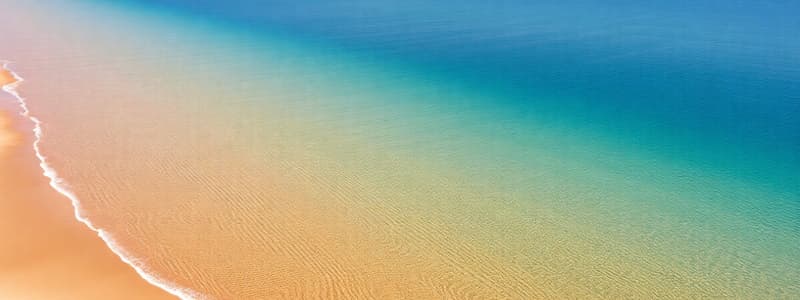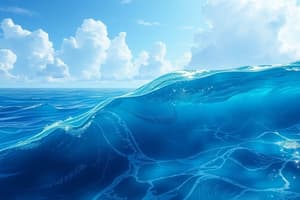Podcast
Questions and Answers
Approximately what percentage of Earth's total water is contained within the world's oceans?
Approximately what percentage of Earth's total water is contained within the world's oceans?
- 85%
- 50%
- 71%
- 96% (correct)
Which characteristic primarily distinguishes seas from oceans according to the provided information?
Which characteristic primarily distinguishes seas from oceans according to the provided information?
- Seas are defined as roughly demarcated areas within oceans, often partially enclosed by land. (correct)
- Seas are larger and deeper than oceans.
- Seas are completely landlocked, while oceans are open.
- Seas contain freshwater, whereas oceans contain saltwater.
What is the primary factor influencing the temperature variation across different oceans?
What is the primary factor influencing the temperature variation across different oceans?
- Ocean depth and volume
- Latitude and hemisphere location (correct)
- Salt content and density of water
- Proximity to continental landmasses
Unlike oceans and seas, lakes are primarily characterized by which of the following?
Unlike oceans and seas, lakes are primarily characterized by which of the following?
Based on the text, how many major oceans are currently recognized on Earth?
Based on the text, how many major oceans are currently recognized on Earth?
Which characteristic primarily distinguishes a sea from an ocean?
Which characteristic primarily distinguishes a sea from an ocean?
The Black Sea's high salinity, approximately 34%, is primarily attributed to which of the following factors?
The Black Sea's high salinity, approximately 34%, is primarily attributed to which of the following factors?
What is a defining feature of a gulf that differentiates it from both seas and oceans?
What is a defining feature of a gulf that differentiates it from both seas and oceans?
Oceans and seas play a crucial role in regulating Earth's climate primarily through which mechanism?
Oceans and seas play a crucial role in regulating Earth's climate primarily through which mechanism?
Which statement accurately describes the hierarchical relationship between oceans, seas, and gulfs in terms of size?
Which statement accurately describes the hierarchical relationship between oceans, seas, and gulfs in terms of size?
Flashcards
What are oceans?
What are oceans?
Large expanses of salt water that exist between continents.
What are seas?
What are seas?
Smaller areas of salt water that are partially surrounded by land.
What influences the density of an ocean?
What influences the density of an ocean?
The density of the ocean varies depending on the temperature and salt content of the water.
How many major oceans are there?
How many major oceans are there?
Signup and view all the flashcards
Where is the deepest part of the ocean?
Where is the deepest part of the ocean?
Signup and view all the flashcards
Ocean
Ocean
Signup and view all the flashcards
Sea
Sea
Signup and view all the flashcards
Gulf
Gulf
Signup and view all the flashcards
Ocean currents
Ocean currents
Signup and view all the flashcards
Salinity
Salinity
Signup and view all the flashcards
Study Notes
Earth's Bodies of Water
- Earth is 71% water, with oceans holding 96% of the planet's water.
- Various water bodies exist, including seas, gulfs, bays, lakes, rivers, and streams.
- Seas are defined areas within oceans, partially enclosed by land.
- Gulfs are sea or water bodies encompassed by land, typically connecting to an ocean or sea.
- Lakes are freshwater bodies surrounded by land, smaller than oceans and seas.
- Rivers are elongated bodies of flowing water.
- Oceans and seas contain saltwater, while lakes and rivers typically hold freshwater.
Oceans of the World
- There are five major oceans: Arctic, Atlantic, Pacific, Indian, and Southern.
- Oceans are vast bodies of seawater mostly between continents.
- Ocean characteristics vary in temperature (warmer near the equator, colder near the poles), density (influenced by temperature and salt content), and depth (ranging from shallow to very deep, with the Mariana Trench being the deepest).
- Average ocean depth is around 12,100 feet.
- The deepest point, Challenger Deep in the Mariana Trench, is over 36,000 feet deep.
Seas of the World
- Seas are large expanses of saltwater, smaller than oceans, located near continents.
- Often partially enclosed by land.
- Seas are smaller portions of an ocean, often inside an ocean basin.
- Examples include the Mediterranean, Black, Philippine, and Coral Seas.
- Seas vary in salinity and size.
- The Black Sea is the saltiest sea, around 34% salinity (compared to ocean salinity around 7%).
- Over fifty seas are identified globally.
Gulfs of the World
- Gulfs are deep inlets of ocean or sea, highly indented and mostly surrounded by land with a narrow mouth.
- Often connect pieces of land to an ocean or sea.
- Examples include the Gulf of Mexico, Gulf of Tonkin, and the Persian Gulf.
- Gulfs are smaller than seas but larger than bays.
- Many gulfs exist worldwide, but precise numbers are not readily available. Locations and associated countries are listed in detail in the provided material
Gulf vs Ocean/Sea/Bay
- Gulfs are smaller than oceans and seas, more enclosed water bodies.
- Gulfs often connect land to ocean/seas.
- Bays are inlets of ocean/sea, typically less enclosed than gulfs.
- Gulfs distinguished by deeper inlets and more enclosed nature compared to bays
Studying That Suits You
Use AI to generate personalized quizzes and flashcards to suit your learning preferences.




